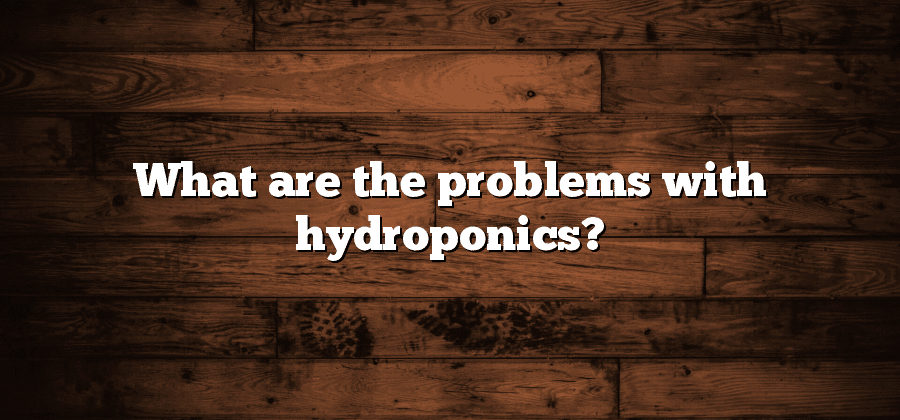Limited nutrient availability in hydroponics systems
Hydroponics systems have gained traction as a modern and efficient method of cultivating plants. However, one of the main challenges faced by hydroponic growers is the limited nutrient availability in these systems. Unlike traditional soil-based farming, where plants can derive essential nutrients from the soil, hydroponic plants rely solely on nutrient solutions supplied by the grower.
The nutrient solutions used in hydroponics must be carefully balanced to ensure that plants have access to all the necessary elements for healthy growth. However, maintaining this balance can be a delicate process, as the nutrient levels need to be continuously monitored and adjusted. Any imbalance or deficiency in these nutrients can result in stunted growth, nutrient lockout, or even the death of the plants. Therefore, hydroponic growers need to have in-depth knowledge of plant nutrition and closely monitor the nutrient solutions to provide optimal nourishment for their crops.
Challenges in maintaining pH levels in hydroponic setups
Maintaining the optimal pH levels in hydroponic setups can pose significant challenges for growers. pH, which stands for potential of hydrogen, refers to the acidity or alkalinity of the nutrient solution in the hydroponic system. In order for plants to thrive, it is crucial to maintain the pH levels within a specific range. Deviations from this range can have negative effects on plant growth and nutrient availability.
One of the challenges in pH maintenance is the volatility of the nutrient solution. Various factors can influence the pH levels, such as nutrient uptake by plants, nutrient interactions, and environmental conditions. As plants absorb nutrients, the nutrient solution can become more acidic, requiring adjustments to bring it back into the optimal range. Conversely, certain nutrient interactions can cause the solution to become more alkaline. This dynamic nature of pH in hydroponic systems demands constant monitoring and adjustment to ensure the plants receive the nutrients they need.
Potential issues with waterborne diseases and pathogens
Waterborne diseases and pathogens pose a significant challenge in hydroponic systems, where plants are grown in a nutrient-rich water solution instead of soil. As these systems rely heavily on water for nutrient delivery, any contamination in the water supply can easily lead to the spread of diseases and pathogens among the plants. This can result in reduced crop yield, poor plant health, and even total crop loss.
One of the main issues with waterborne diseases and pathogens in hydroponics is the difficulty in identifying and addressing the source of contamination. Unlike traditional soil-based farming, where pathogens are often localized in specific areas, contaminated water can quickly transmit diseases throughout an entire hydroponic setup. This poses a unique challenge for growers, as it requires stringent monitoring and testing of the water supply to prevent the introduction and spread of harmful microorganisms. Additionally, the absence of natural filters and buffers usually found in soil can heighten the vulnerability of plants to these pathogens, making early detection and prompt action crucial in maintaining the health and productivity of the crop.
Difficulty in managing and preventing root diseases in hydroponics
Root diseases pose a significant challenge in hydroponics systems, requiring careful management and prevention strategies. Unlike traditional soil-based farming, hydroponic setups provide a controlled environment for roots to grow, but this also means that any potential root diseases can spread quickly and severely impact plant health. The absence of soil also means that the roots have limited physical barriers to protect against pathogens, making them more vulnerable to infections.
Preventing and managing root diseases in hydroponics involves a multi-faceted approach. Firstly, maintaining good hygiene practices is crucial to minimize the introduction and spread of pathogens. This includes regularly sterilizing equipment, using sanitized tools, and providing a clean and well-maintained environment for the plants. Secondly, selecting and using disease-resistant plant varieties is important to minimize the risk of infections. Additionally, implementing strict water management protocols, such as regular monitoring of nutrient solution pH and oxygen levels, can help prevent root diseases in hydroponic systems. Overall, proactive disease prevention measures and diligent management are essential to ensure the long-term success and productivity of hydroponic setups.
The high initial investment required for hydroponic systems
Hydroponic systems have gained popularity in recent years due to their ability to produce high-quality crops with limited space and resources. However, one of the biggest challenges that potential growers face is the high initial investment required to set up a hydroponic system. Unlike traditional soil-based farming, hydroponics involves using specialized equipment such as grow lights, pumps, nutrient solutions, and media, which can be quite expensive.
The cost of purchasing and installing these components can deter many individuals from pursuing hydroponic farming as a viable option. Additionally, it is crucial to consider the ongoing expenses associated with maintaining the system, such as electricity bills for running the lights and pumps, as well as the cost of replenishing nutrient solutions and replacing any damaged or worn-out equipment. Therefore, would-be hydroponic farmers must carefully calculate the upfront and recurring costs to determine if it aligns with their budget and long-term goals.






